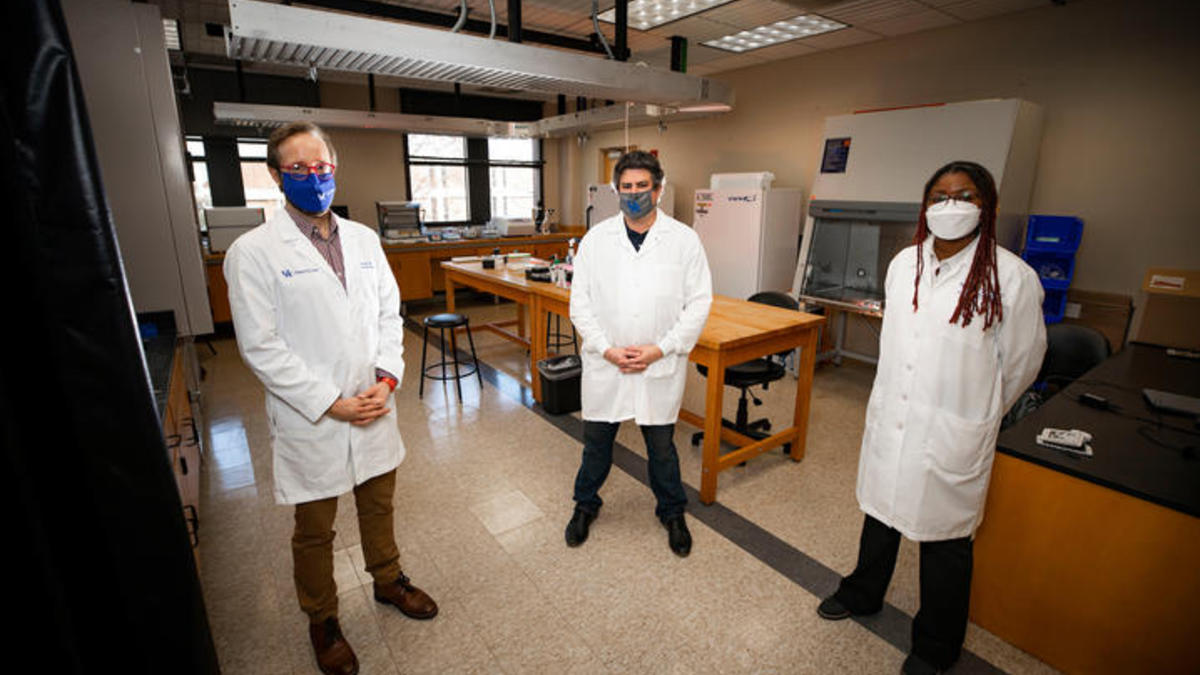By Elizabeth Chapin
Researchers in the University of Kentucky’s College of Medicine and College of Engineering are testing a new technology to evaluate wastewater to track community presence of COVID-19.
Assistant Professor of Family and Community Medicine James Keck, associate professor of mechanical engineering Scott Berry and Assistant Professor of Civil Engineering Shakira Hobbs are collaborating on a pilot project to test the new technology, as well as analyze the stability of SARS-CoV-2 in wastewater. The results could impact how public health officials track COVID-19 outbreaks.
Historically wastewater testing has seen limited use to identify outbreaks of infectious diseases in communities. The COVID-19 pandemic has brought newfound interest in this approach because it can monitor infection trends without extensive clinical testing. For COVID-19, the surveillance strategy evaluates wastewater for the presence of SARS-CoV-2, the virus that causes the disease. Wastewater includes water from household and building use that can contain human fecal waste, which can be tested for SARS-CoV-2 RNA.
At UK, Keck’s research team is already helping to conduct COVID-19 wastewater testing for on-campus residence halls to help provide guidance to testing, tracing and screening protocols. While the team is assisting with efforts to track and control COVID-19 at UK, their pilot project Wastewater Assessment for Coronavirus in Kentucky (WACKY), could help address the global pandemic by making wastewater testing for the virus more efficient and affordable.
After working in rural Madagascar during the beginning of the COVID-19 pandemic, Keck reached out to Engineering colleagues Hobbs and Berry to initiate the project.
“We have the expertise and equipment to advance testing procedures and understand more about the virus’ presence in wastewater—gaining knowledge that can help not only our local community but also areas around the world that may lack testing infrastructure,” Keck said. “The testing can be an especially important tool in rural areas with weak healthcare and technology infrastructure and limited clinical testing options.”
The study’s first objective is to understand how SARS-CoV-2 degrades in wastewater under different environmental conditions. The results will help researchers understand what factors are most influential to the degradation of the virus in samples.
For this, the team is gathering samples from a Lexington wastewater treatment plant and “spiking” them with a synthetic form of SARS-COV-2. The samples are then sent to Hobbs’ lab, which has an environmental chamber where they are exposed to three different variables: UV light, temperature and pH. Then they are analyzed to see how the viral particles degrade over those conditions.
“This understanding can help public health officials get more accurate results – not only considering environmental factors but also how long samples can be preserved before analyzing to still get an accurate reading,” Hobbs said.
The team is also testing a new technology called exclusion-based sample preparation (ESP) to extract SARS-CoV-2 RNA from the wastewater. The ESP device, invented by Berry, uses special beads to extract the RNA, which can then be put into a polymerase chain reaction (PCR) test for further analysis.
“ESP can provide a fast and simple method to manipulate RNA and has the potential to improve testing sensitivity and help to create a low-cost way to expand testing in rural areas or developing countries,” said Berry.
Berry initially developed ESP to measure the viral load in blood samples of HIV patients. This is the first study to track its effectiveness to test for a virus in wastewater. Berry says the goal moving forward is to modify ESP to create a more manageable field test that could also accommodate larger samples.
After the six-month project concludes in December, the research team plans to continue advancing the ESP technology. They also plan to publish the results from the environmental degradation part of the study early next year.
The pilot grant was funded in part by UK’s COVID-19 Unified Research Experts (CURE) Alliance through the Vice President for Research and the College of Medicine and the Center for Clinical and Translational Science (CCTS).
The pilot has served as a kickstarter for related research, including a recent $1.2 million Centers for Disease Control and Prevention grant that will fund wastewater research that can help public health officials get early warning signs for COVID-19 outbreaks in nursing homes.
The CURE Alliance/CCTS funding has provided a number of researchers at UK like Hobbs, Berry and Keck the opportunity to collaborate across disciplines and garner funding while utilizing the expertise and equipment available across campus to address the global pandemic.
